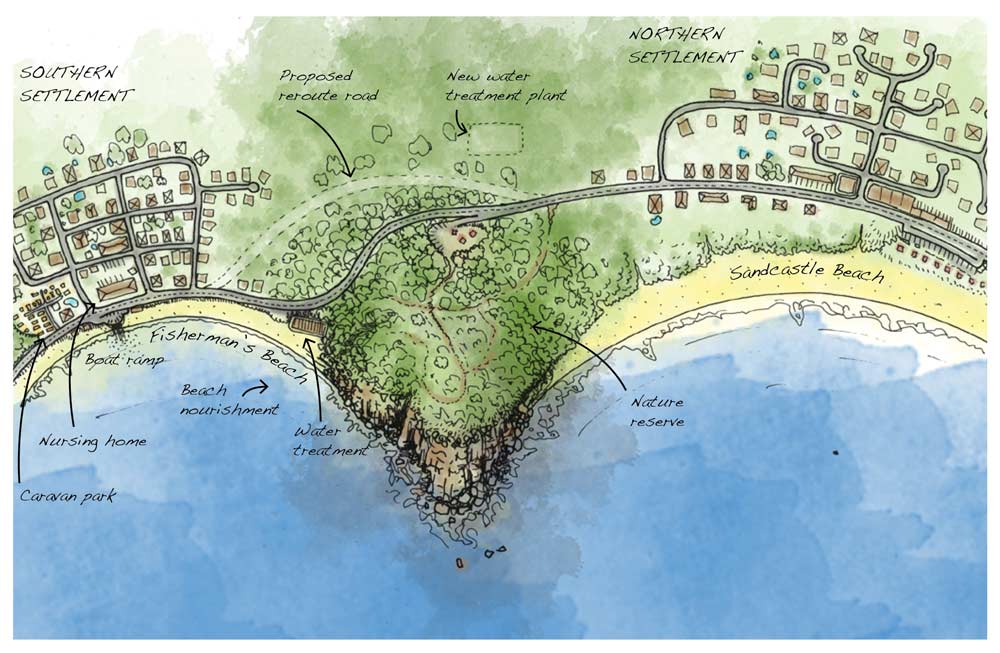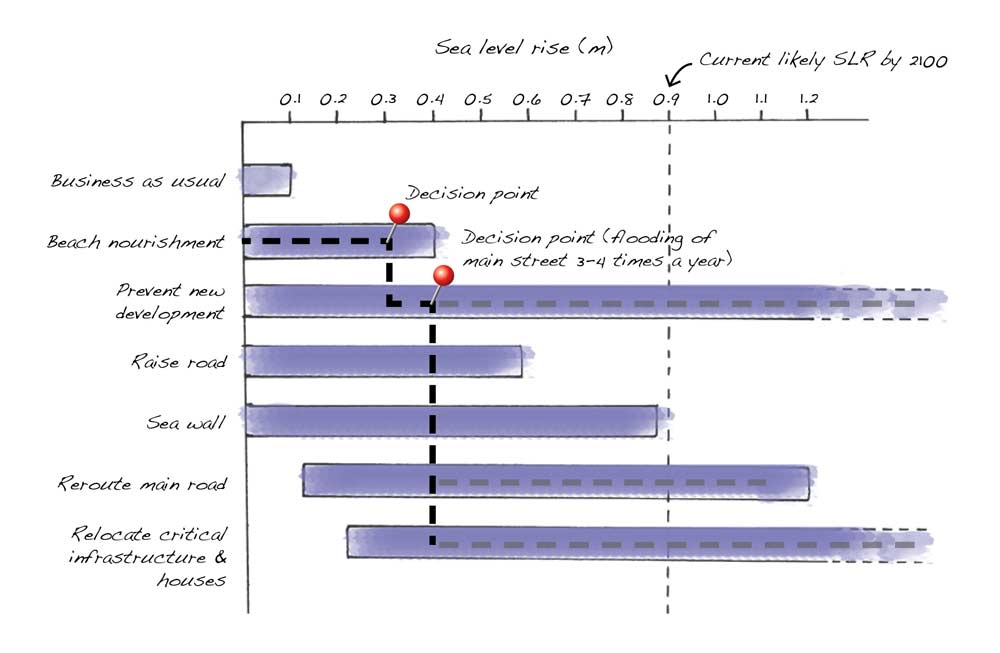You are here
Applying a pathways approach
To demonstrate how a pathways approach may be used in adaptation decision-making, we present a hypothetical worked example about coastal protection.
At a glance
- An adaptation pathways approach is designed to keep options open— some actions are to be taken now, some actions may be taken in the future— and to build flexibility into planning.
- For coastal managers the pathways approach supports strategic, structured and planned decision-making.
- This worked example demonstrates the key features of the pathways approach. It should be read in conjunction with Pathways approach.
Main text
1. Setting the context
The adaptation challenge: The hypothetical coastal local government at Sandcastle Bay is considering how it will adapt to rising sea levels and the risk of inundation to its small tourist and fishing community of Sandome (Figure 1).
T4W2_Figure-1.jpg

The location: Sandome is settled in two halves, with a range of older housing in the original fishing settlement to the south of the headland and a newer vibrant township on the northern side. Sandome is a popular family holiday destination due to its white sand beaches and there is a large retiree population, a strong fishing industry and a nature reserve on the headland that attracts weekend visitors.
Current conditions: Sandome is experiencing a growing problem of beach erosion in the original fishing settlement. Beach erosion has always been an issue, but older local residents are clear that the situation has worsened in recent years. During the last major storm the main road into the southern settlement was severely damaged, resulting in restricted traffic between the northern and southern settlements. Once or twice a year there is flooding in the southern settlement that affects several houses, a nursing home and the water treatment facility.
To address present and future risks, the council has proposed a moratorium on all future development. The proposed controls are very unpopular with local homeowners. As part of a broader adaptation planning exercise, the council is undertaking consultation with the community to map out and explore potential ways forward, based around a pathways approach (see section 8 of Information Manual: Costs and benefits and Pathways approach for more details on the pathways approach).
2. Taking a pathways approach
Community engagement and consultation: Sandcastle Bay Council have begun engaging with the Sandome community to consider future options for their settlement. The council hopes to identify and build acceptance for future options that will protect the settlement and avoid costly repairs to the water treatment facility.
After initial one-on-one discussions with key community members and meetings with community groups, a workshop with the wider community was organised. The goal was to bring together residents and the council to identify and explore the development and conservation priorities of the community for the future. The discussions were informed by local studies, including inundation modelling (to identify areas at high risk from sea-level rise) and geological surveys, and scientific information (future climate scenarios). The sea-level rise scenarios ranged from 0.6 m (for a lower greenhouse gas future) (see Infographic: What are RCPs?) to 0.8 m (business-as-usual) towards the end of the century.
Residents identified the importance of staying within the Sandome community and accessing a jetty for fishing. It was also clear that the community valued the nature reserve both as a recreational space and for conserving local wildlife, and would not tolerate the loss of that area.
Table 1 summarises the outcomes from the workshop, in terms of the adaptation options identified and the community and council attitudes to each of these. The table attempts to map out the levels of protection that might be afforded by each option, as well as any associated potential negatives.
Table 1: Outcomes of consultation exercise
| Adaptation option | Community response | Council response | Comments, including level of risk addressed |
|
Business as usual |
Loss of nature reserve unacceptable. Risk of damage to properties, particularly in the south, and high costs of remediation to residents and council. Disproportionate spending in the older southern half of the town highlighted by some residents. |
Risk to council infrastructure, concern about future liability. |
Township likely to become uninsurable within next 10 years. |
|
Beach nourishment |
Preferred as it is aesthetically pleasing. |
Council have undertaken ad hoc beach nourishment in the past following severe storms. A source of sand would be needed. |
This would provide reasonable protection of properties and infrastructure for up to 0.4 m of sea-level rise. |
|
Prevent further new developments within current town footprint including extensions and replacement of existing properties |
Some residents were concerned about not realising financial returns on their property investment; others recognised that short term gains from continued development could be erased by long term liabilities. |
This change is important to limit council legal liability given that the risks are known. The urgency is greatest in the southern half of the town and new developments in the northern half. |
Some areas of potential development are already at risk of flooding once or twice a year. At 0.8 m sea-level rise most properties are at some risk of flooding and some infrastructure could expect almost permanent inundation. |
|
Raise or relocate sections of the main road to reduce flooding risk |
Wide support, although some traders were concerned that any rerouting might reduce business. |
Council has investigated this option, but resources have previously gone into road repairs. Raising the road level will create other water flow and traffic problems that would need to be addressed at the same time. Rerouting the most vulnerable section through an existing council reserve would cause minimal disruption to recreation areas. |
Raising the road level offers risk reduction for sea-level rise of up to 0.6 m, while rerouting is likely to offer protection to 1.2 m of sea-level rise. |
|
Construct sea wall to protect properties |
Some feel this will create security for their property, others believe it will change the beach front too much and will create erosion problems for the nature reserve. |
This is an expensive option and will create ongoing maintenance issues. It is feasible from an engineering perspective, but there need to be studies of final costs and impacts on beach characteristics. |
Proposed design will only offer protection for 0.8m sea level rise. Would take 2-3 years to complete sand studies and construct. |
|
Managed relocation of critical infrastructure to higher, northern part of town |
The vulnerability of some critical infrastructure is well understood. The nursing home was inundated during storms twice in the last decade. |
Council does not want to see more development in areas subject to flooding. Has land available to relocate some infrastructure. |
Residents identified that, if flooding cuts the access road three times a year, the risk will become unacceptable to the community. |
|
Abandon southern settlement |
Following initially strong negative reactions the community came to understand why this was presented as an option. They conceded it might be a 'last-resort’ option for use when current residents leave or die. |
Council was cautious about this option, recognising it could place a financial burden on council to acquire these properties. It would be a very long-term solution. |
This option requires a comparison of the costs and levels of protection of abandonment versus a seawall. |
Major points that emerged from the workshop are:
- The community’s preference was for staged relocation, as the northern community expands and more infrastructure is needed on that side, rather than investment in a seawall. Council identified appropriate land that could be rezoned for new development including a nursing home and a new water treatment facility that could be considered when the existing one comes due for major upgrade in about 20 years.
- The community remained concerned about the immediate prohibition on new development, but was willing to accept a concessional approach that would allow for some renovation of existing properties, the cessation of development of new properties and options for relocation (land swap) of existing properties at risk.
- The community’s overall sense was that the southern settlement could continue to be enjoyed as a fishing settlement in the short term, but that the future of the community was better invested in the northern township.
- Financing of the options was seen to fall largely on the council and it was considered that further analysis of costs and benefits would be needed before any plan could be finalised.
Developing the adaptation pathway. Following the workshop, the council prepared a draft visualisation of the adaptation options. An adaptation pathway was plotted. The most likely first step along this pathway is to develop and implement a formal beach nourishment program. This may be followed by a staged reduction of development with longer-term plans for relocation of infrastructure, housing and the road as sea level increases. These proposals were tested through subsequent rounds of community engagement and modified to produce a preferred adaptation pathway (Figure 2).
T4W2_Figure-2.jpg

The next step for the council was to develop costings of the proposed options in order to test the suitability and feasibility of the preferred adaptation pathway. The council undertook a further round of consultation to present a finalised and costed pathway.
3. The outcomes
With general agreement on the preferred adaptation options, the Sandcastle Bay Council was able to build an adaptation plan that begins with a simple beach nourishment program. When sea level rises by about 30 cm, this will shift to new development controls that prevent new development in high-risk areas. The council will be able to start preparing for these changes now. As sea levels increase by approximately 40 cm, longer-term and financially significant options will need to be considered, including relocation of the water treatment plant, development of a new nursing home and rerouting of the main road. Identifying the triggers for adaptation action helped both the council and community to understand the significant challenge ahead but also to realise they have time to prepare for and undertake actions that will help reduce the community’s risk.
The council and community understood through the process that the pathways map will need to be regularly revisited and tested, as new scientific understanding of risks emerges and new technologies expand the range of adaptation options. As sea level continues to rise, thresholds in the pathways map will be crossed, and the actions identified in the map will need to be implemented.




